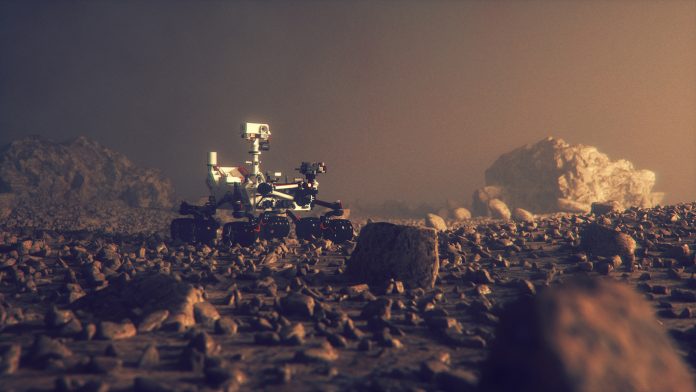Norwegian company SINTEF is developing a new 3D robot that explores the surface of planets and identifies space junk.
Originally, the camera was designed to roam the surface of Mars through a collaboration between the European Space Agency (ESA) and Russia. However, following the war in Ukraine, this project has been abandoned and SINTEF is looking to target regions closer to Earth.
“Mars is still an interesting target for us,” said SINTEF’s Jostein Thorstensen. “But right now, it all seems a little far away, so we’re looking at other opportunities. Servicing satellites and the removal of space junk have emerged as very interesting areas.”
There are thousands of satellites and many of them require servicing and repairs in order to extend their lifetimes. Increasing amounts of space junk are also becoming a major problem, with thousands of decommissioned satellites still in orbit around Earth.
The ExoMars programme
In September 2022, the ESA had planned to send a robot to Mars in collaboration with Russia’s national space agency, Roscosmos. However, due to Russia’s invasion of Ukraine, the ESA withdrew from the project. The rover, named Rosalind Franklin, is currently stationed in Italy and is ready to depart to space, but with the abandonment of the project, it is unclear how it will travel to Mars.
The intention of the ExoMars programme was for the rover to collect samples of space junk and drill a borehole at a depth of two metres. The space junk samples would then be collected and sampled on Earth in order to fuel a future mission.
The ESA and Roscosmos have previously collaborated in 2016. Together, they launched a space vehicle carrying a satellite which continues to orbit Mars today. This satellite is measuring gases that may provide indications of life on the planet.
At the same time as the satellite was put into orbit, a test landing was carried out using an Italian-built test module called Schiaparelli EDM. However, the landing procedure was initiated too early and the vehicle crash-landed at 300 kilometres per hour.
Environmental conservation in space
The ESA is keen for its space projects to promote environmental protection in space. Between three and four thousand of the satellites sent into Earth’s orbit since 1957 now represent space junk.
The number of satellites orbiting our planet is growing explosively. Since 2019, the Elon Musk-owned company SpaceEx has launched more than 3,000 satellites into low Earth orbits. This is just the beginning, as Musk’s Starlink system consists of small, low-tech satellites. But others may be much larger and more complex, costing hundreds of millions of Norwegian kroner.
How the new robot identifies space junk
To create the 3D robot, the researchers used the same principle as the human eye. Our eyes provide us with stereoscopic vision, which enables us to see things differently and use depth vision. When an object is close, we usually squint to get it into focus.
Using this technique, the team at SINTEF mounted two cameras equipped with a laser. These were positioned within a short distance from each other and projected a pattern onto the object that requires mirroring. This technique enables the robot to record 3D imagery of space junk.
The cameras operate with a resolution of 500×500 pixels with each pixel capable of measuring with an accuracy of 0.2 millimetres. The pattern projected onto the object by the laser creates a unique code in the pixels of the two cameras. But the code will not be positioned in exactly the same place on the image.
The displacement between the two cameras enables detailed information to be obtained about the distance to the object. By using triangulation, combined with advanced data processing, it is possible to build a three-dimensional image.
A space junk-targeting robot equipped with a camera and operating in orbit around the Earth has to be robust. SINTEF’s camera system has succeeded in demonstrating that it is exactly that. In preparation for the extreme conditions on Mars, the equipment was subjected to testing under harsh conditions.
SINTEF’s Runar Dahl-Hansen says that the camera has to withstand severe shaking, high and low temperatures in a vacuum, high exposure to gamma radiation, and electric fields five times stronger than a lightning strike.
Dahl-Hansen explained: “In fact, the properties of the microscopic mirror become enhanced after exposure. Stress tests have been found to induce beneficial chemical defects and cause them to be distributed in such a way that they improve the performance of the piezoelectric material.”
Piezoelectric materials are able to convert electrical energy into mechanical energy, and vice versa. Their efficiency is very high, with up to 90% of the energy being conserved during the process. SINTEF’s 3D camera is equipped with a millimetre-sized piezoelectric mirror that has been developed and constructed at SINTEF’s MiNaLab. The mirror can be used to control and manipulate light with nanometre precision.
Market potential and SINTEF’s future projects
The use of 3D cameras is important not just to target space junk, but in many other areas. Thorstensten said: “The use of and need for specialised 3D cameras is on the increase. For example, organisations operating in fields such as industrial robotics, logistics, medicine, and inspection are all interested in highly miniaturised cameras offering high-quality 3D data.”
He continued: “The ESA was so pleased with the camera that it awarded SINTEF funding for a follow-up project. We’re still in a relatively early phase. The technology will not be ready for use in space for several years. But interest from major space sector players offers hope that in the future, SINTEF technology can look forward to a role in space – either on a Martian rover or a servicing satellite.
“It is compact, consumes very little energy, and provides fantastically detailed close-up images. Weight, size, and energy consumption are key factors when you put a robot into Earth orbit. Our system has fewer complex optics control electronics than other 3D cameras, which makes it potentially more robust and reliable for identifying space junk.”









